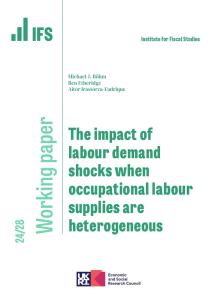The Office for National Statistics have released the latest data on the distribution of employees’ earnings in the UK, based on the Annual Survey of Hours and Earnings (ASHE), the highest quality source of data on employees’ pay in the UK. The survey, of around 180,000 employees, is undertaken in April of each year and the latest data is available for 2019.
In this short briefing note, we use the latest ASHE data to look at how earnings have changed over the last 11 years, how that differs when looking at hourly and weekly pay, and how different groups have seen different trends. In particular, we focus on how the trends have differed by sex, age, region and nation of the UK, as well as how they have differed across the earnings distribution.
Key findings
- The latest data for April 2019 show median weekly earnings still being 2% below their April 2008 level, despite growth of 2.1% since April 2018. Median hourly earnings have performed slightly less badly since 2008, and have essentially returned to their 2008 level. However, on either measure there has essentially been a “lost decade” of average earnings growth since the recession.
- Weekly earnings growth for men since 2008 has been particularly poor: still 6% below their 2008 level. This is in part due to falling hours of work for men. Average male weekly earnings were no higher in 2019 than they were in April 2001, after accounting for inflation.
- Large increases in minimum wages have massively boosted the earnings of those with low hourly pay. The 10th percentile of the hourly earnings distribution is 11% higher than it was in 2008. However, these gains have partly, but not completely, fed through into higher pay for those with low weekly earnings. This was in part due to falling hours for low earners between 2016 and 2018, although this trend did not continue in 2019.
- Weekly earnings growth for men with low earnings has been disastrous since 2008. Between 2008 and 2014, for men at the 10th percentile of the weekly earnings distribution, pay fell by 20%. It has recovered somewhat since then. But in 2019 it is still 12% below its 2008 level. This looks to be mainly due to falling hours of work for these people.
- Average earnings for those in their 30s, and in London, have performed worst since 2008. Median earnings for those in their 20s fell dramatically after 2008, but have recovered strongly, leaving those in their 30s as by far the worst performing age group. Richer regions like London and the South East have done worst. Poorer regions like the West Midlands and North East fared much less badly.











